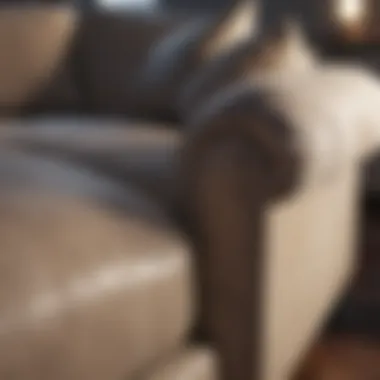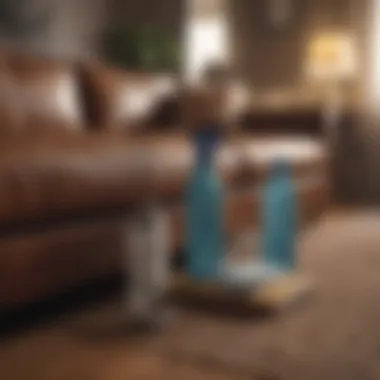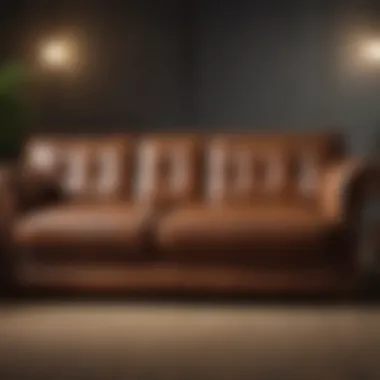Effective Strategies for Cleaning Your Couch


Intro
Couches are essential elements in our homes. They provide comfort, style, and a place for gathering. However, they easily accumulate dirt, stains, and odors, which can diminish their appeal and lifespan. Cleaning your couch is not just about aesthetics; it impacts the health and well-being of your living environment. It's crucial for homeowners and interior design enthusiasts alike to understand the proper techniques and methods for different fabrics and materials. This guide aims to present effective strategies for maintaining the integrity of your couch.
Material-Specific Cleaning Techniques
Understanding the material of your couch is paramount. Different fabrics require specific cleaning methods to avoid damage.
Leather Couches
Leather sofas are elegant but can be challenging to clean. Use a soft cloth with a mixture of warm water and mild soap. Additionally, applying a leather conditioner keeps the material supple. Avoid abrasive cleaners as they can strip the leather of its natural oils.
Fabric Couches
Fabric upholstery can often trap dust and allergens. Use a vacuum to remove loose particles. For stains, mix a gentle detergent with water, applying it with a soft cloth. Always test any solution on a hidden spot first to prevent discoloration.
Suede Couches
Suede requires specialized care. Regular brushing with a suede brush can remove dirt. For stains, consider using a specific suede cleaner. Never use water as it can create watermarks, damaging the fabric's texture.
Recommended Cleaning Supplies
Selecting the right cleaning supplies is critical for effective maintenance. Here are some essentials:
- Vacuum Cleaner: For weekly upkeep, a vacuum helps eliminate dust and debris.
- Microfiber Cloths: Ideal for gentle cleaning without scratching the surface.
- Mild Detergent: Necessary for spot cleaning stains.
- Leather Conditioner: Protects and preserves the look of leather couches.
- Suede Brush: A must-have for maintaining suede material.
"Regular maintenance will prolong the life of your couch significantly, making it a wise investment."
Stain Removal Tips
Stains are a common issue. Quick response is essential.
- For food stains, gently blot with a damp cloth. Avoid rubbing; this may spread the stain.
- For ink stains, spray a small amount of isopropyl alcohol onto a cloth and blot carefully.
- Grease stains require cornstarch. Sprinkle it on the stain, let it sit, then brush it off after a few hours.
Protecting Your Couch
Lasting beauty requires preventive measures. Covers and throws can shield against everyday wear and tear. Moreover, placing your couch away from direct sunlight helps prevent fading over time.
Understanding Different Couch Fabrics
Couches come in various fabrics, and each type has its own cleaning needs. Understanding different couch fabrics is crucial for maintaining the aesthetic and longevity of your furniture. Each material interacts differently with stains, spills, and cleaning products. By knowing the characteristics of your couch fabric, you can select appropriate cleaning methods that ensure effective maintenance without damaging the material.
Cotton
Cotton is a popular choice due to its natural look and feel. It is generally soft, comfortable, and breathable. Moreover, cotton can be cleaned effectively with water-based solutions. It is resistant to fading but can absorb spills quickly, making it susceptible to stains. Using a microfiber cloth or a gentle upholstery cleaner can help tackle both stains and soil. It is important to test any cleaning agent in an inconspicuous area first to ensure there’s no discoloration. Regular vacuuming helps to keep the fabric free from dust and dirt, prolonging its life.
Leather
Leather is a classic and luxurious option that adds elegance to any space. This fabric is durable, easy to clean, and resistant to spills when maintained properly. However, it requires specific care; harsh cleaners can damage the surface. A soft, damp cloth is often enough for routine cleaning, while specialized leather cleaners can be used for deeper cleaning. Conditioning leather regularly helps keep it supple and prevents cracking. Avoid excessive exposure to direct sunlight, as it can lead to fading.
Microfiber
Microfiber is renowned for its stain-resistant properties. This synthetic fabric has tightly woven fibers that repel liquids, making it an excellent choice for households with children or pets. Cleaning microfiber requires minimal effort; usually, a simple solution of mild soap and water can suffice for most stains. It dries quickly and often does not require deep cleaning. To maintain its appearance, regular vacuuming or using a soft brush is recommended. However, be cautious with overly wet cleaning methods that can lead to watermarks.
Synthetic Fabrics
Synthetic fabrics, such as polyester or nylon, are commonly used for couches. These materials are often more resistant to stains and fading compared to natural fabrics. However, they can attract static electricity, which might lead to dust accumulation. Cleaning synthetic fabrics usually involves mild soap and water, or a specialized upholstery cleaner, depending on the manufacturer's recommendations. Be mindful that some synthetic materials may not react well to water, so testing is advisable.


Blend Fabrics
Blended fabrics combine natural and synthetic materials, offering durability and comfort. These fabrics often inherit the best qualities of both types, making them versatile for various uses. Cleaning blend fabrics can require different approaches based on their composition. Always check the care label for specific instructions. Regularly scheduled maintenance, such as vacuuming, can prevent dirt buildup and maintain their appearance. Stain treatment should be addressed promptly to avoid setting.
Initial Assessment Before Cleaning
Before diving into the cleaning process, taking the time for an initial assessment is essential. This stage lays the groundwork for effective couch maintenance and ensures the process aligns with both the material and the condition of the couch. A proper assessment can save time, prevent damage, and yield better results.
Identifying the specific issues and understanding the fabric type can significantly influence the choice of cleaning method and supplies. By recognizing stains and any special care requirements, homeowners can adapt their strategies more effectively.
Furthermore, this preparation can help in preventing oversight that might lead to complications later on in the cleaning process, ensuring a smoother and more successful outcome.
Identifying Stains
Stains vary widely in nature, from food and drink spills to dirt and pet accidents. The first step in the initial assessment is to identify these stains accurately. Each type demands a tailored approach. For example, a red wine stain will require different treatment compared to an ink stain.
Some common stain types include:
- Organic stains: from food, drinks, or pets, often requiring enzymatic cleaners.
- Inorganic stains: such as grime or dirt, often best treated with a simple soap and water solution.
- Dyes: from certain fabrics or materials may necessitate specialized stain removers.
Take note of the size and depth of the stains, as larger or deeper stains might need more intensive treatment. This attention to detail will inform your cleaning strategy.
Checking for Special Care Requirements
Not all couches are created equal; some come with specific cleaning instructions provided by the manufacturer. These instructions are critical to follow, as they often specify the safest products and techniques for that particular fabric.
Special care requirements might include:
- Water-based cleaning restrictions, necessary for delicate fabrics.
- Avoidance of heat or harsh chemicals which can alter the color or texture of the material.
- Recommendations for specific cleaning agents or treatments suitable for certain fabrics like leather or microfiber.
Check the care tag, usually located under a cushion or on the bottom of the sofa. Ignoring these guidelines can lead to further damage, costing more in repairs or replacements down the line.
"Proper assessment before any cleaning action saves not only time but also extends the life and beauty of the couch."
By thoroughly understanding the stains and the fabric of your couch, you position yourself to clean effectively and efficiently, ultimately achieving lasting results.
Essential Cleaning Supplies
Cleaning your couch effectively requires the right tools. Essential cleaning supplies play a vital role in addressing dirt, stains, and overall maintenance. Having the appropriate items at your disposal not only ensures a thorough clean but also protects the integrity of your couch fabric.
When looking for cleaning supplies, consider both effectiveness and compatibility with your couch material. Each tool comes with its own advantages. Understanding these can save you time and prevent damage to your furniture.
Vacuum Cleaner
A vacuum cleaner is a fundamental tool in any couch cleaning regimen. It helps to remove loose dirt, dust, pet hair, and debris from the surface and crevices of your couch. Frequent vacuuming prevents dirt from embedding into the fibers, making deeper cleans easier.
- Considerations: Ensure to use a vacuum with an upholstery attachment to effectively clean without causing damage.
- Benefit: Regular vacuuming prolongs the life of your upholstery.
Upholstery Cleaner
An upholstery cleaner is crucial for spot cleaning and addressing specific stains. These cleaners are specially formulated for different types of couch fabrics, making them less likely to cause damage compared to general cleaning agents.
- Important: Always check the labels and select a cleaner that is compatible with your couch material.
- Application: Follow instructions closely to avoid over-saturating the fabric, which can lead to mildew or water stains.
Soft Brushes
Soft brushes are essential for cleaning delicate fabrics without risk of damage. They can help lift dirt from the surface and are ideal for scrubbing away stains when combined with an appropriate cleaner.
- Tip: Use gentle, circular motions to avoid pulling or fraying the fabric.
- Result: The right brush maintains a clean appearance without compromising the fabric’s texture.


Cloths and Towels
Cloths and towels are versatile cleaning companions. They are useful for both applying cleaners and absorbing excess moisture after cleaning. Using microfiber cloths is particularly effective due to their absorbent properties and ability to trap dust.
- Use: Have a collection of cloths ready for immediate stain treatment as well as for overall cleaning.
- Benefits: They minimize the risk of leaving lint on the fabric.
Protectant Sprays
Maintaining the clean state of your couch is easier with protectant sprays. These sprays add a layer of defense against stains and spills. Applying a protectant can render the fabric more resistant to liquids and dirt.
- Application: Apply according to the manufacturer's instructions for optimal results.
- Consideration: Reapply periodically, especially after thorough cleaning, to ensure ongoing protection.
"Choosing the right cleaning supplies is the first step in ensuring your couch stays fresh and looking its best."
Equipping yourself with these essential cleaning supplies arms you with the tools needed for efficient and effective maintenance of your couch. Each item serves a specific purpose and, when combined wisely, forms a comprehensive approach to couch care.
Step-by-Step Cleaning Procedure
Cleaning your couch requires a methodical approach to ensure the task is carried out effectively. A structured cleaning procedure not only enhances the look of your couch but also prolongs its lifespan. When each step is followed meticulously, the risk of damaging the fabric or leaving behind stains decreases significantly. This section will outline a systematic approach to couch cleaning, detailing how to prepare the couch, the best vacuuming techniques, methods for spot-cleaning, the overall cleaning process, and final touches that confirm your work is complete.
Preparation of the Couch
Preparation is key before diving into the cleaning process. Start by removing any cushions or removable parts. This allows for better access to all areas of the couch. Next, check for any loose items between or under the cushions. It may also be helpful to read the care label on your couch to understand what products are safe to use. Some fabrics can react negatively to certain cleaners, so identifying these specifics is crucial.
Additionally, moving the couch lightly can expose dust or dirt on the underside, which can be cleaned as well.
Vacuuming Technique
Vacuuming is an essential part of the cleaning procedure. First, equip your vacuum with the proper attachment. The nozzle should be suitable for upholstery to avoid snagging or damaging the fabric. Use the vacuum to cover the entire surface, including the back and sides. Pay special attention to seams and crevices where dust can accumulate. A tip to enhance effectiveness: use short, controlled strokes rather than long sweeps. This method helps to lift dirt rather than just push it around.
After vacuuming, take time to inspect for any visible stains that may require further spot treatment.
Spot Cleaning Stains
After vacuuming, it's time to address any stains. Identify each stain's nature—whether it is water-based, oil-based, or from food. This is important because different stains require different cleaning agents. For water-based stains, a mild upholstery cleaner may suffice. For oil stains, you might use a solution of dish soap and water. Apply the cleaning solution gently using a cloth. Always blot rather than rub to avoid spreading the stain or damaging the fabric. Rinse with a damp cloth after cleaning to remove any residue.
Overall Cleaning Process
Once initial preparation and spot cleaning are completed, it's time to tackle the full cleaning. If your couch is fabric, consider using a steam cleaner. This method provides a deep clean without soaking the fabric. Run the steam cleaner according to the manufacturer's instructions, ensuring that you do not over-wet the fabric, as moisture can lead to mold or mildew growth. For leather couches, it is advisable to use a specialized leather cleaner. Apply with a soft cloth and avoid saturating the leather.
Drying and Finishing Touches
After the cleaning is complete, focus on the drying process. If you have used significant moisture, ensure proper air circulation around the couch. Opening windows or using fans can accelerate drying time. Avoid using the couch until it is completely dry. Once dry, replace the cushions and any decorative items. Consider applying a protectant spray suitable for your couch fabric to safeguard against future stains and spills. Taking these additional steps can maintain the cleanliness and aesthetic appeal of your couch over time.
Common Mistakes to Avoid
Cleaning your couch can maximise its lifespan and maintain its aesthetic appeal. However, some common missteps can lead to more harm than good. Being aware of these mistakes is crucial for both effective care and long-lasting results.
Using Wrong Cleaning Products
One major mistake is selecting cleaning products that are unsuitable for your couch's fabric. Not all materials respond well to the same cleaning agents. For example, using ammonia-based cleaners on microfiber can cause the fabric to become matted and lose its softness. Similarly, certain leather cleaners may strip the natural oils from leather, leading to cracks and irreversible damage.
It is critical to read labels carefully and choose products specifically designed for your couch’s material. Prioritizing appropriate agents not only improves cleaning efficiency but also helps retain the fabric's integrity. Take the time to conduct a patch test on a discreet area to ensure no reactions occur.
Over-Wetting the Fabric
Another mistake is applying too much moisture when cleaning. Some fabrics, like cotton, can absorb water but may take a considerable time to dry. If the sofa remains damp, this can promote mold growth and unpleasant odors. Conversely, other materials like leather can get damaged with excess moisture, causing warping and staining.
To prevent this, use only the recommended amount of liquid cleaner and ensure that the fabric is not soaked. Employ gentle techniques, like dabbing instead of scrubbing harshly, and use microfiber towels to blot up excess moisture. Keeping the fabric condition in check is essential for both function and beauty.
"It is often easier and more effective to clean a couch gradually rather than saturating it all at once."
Neglecting Manufacturer’s Instructions


Every couch comes with specific care instructions from the manufacturer. Ignoring these guidelines can lead to mistakes that void warranties or cause long-term damage. Each fabric showcases different qualities and vulnerabilities. If left unchecked, actions taken without understanding these instructions can harm not just the sofa but also your investment in it.
Referencing these guidelines should be a priority. They often guide you on suitable cleaning methods, recommended products, and care tips tailored specifically for your couch. Following manufacturer advice not only enhances cleaning efficiency but also extends the lifespan of the furniture.
Maintaining a Clean Couch
Maintaining a clean couch is fundamental for a few key reasons. First, a clean couch enhances the overall aesthetic of your living space. It is a focal point in any room, and cleanliness reflects personal hygiene and attentiveness to home upkeep. Second, couches endure regular use, leading to the accumulation of dust, dirt, and stains. If neglected, these elements can degrade fabric quality over time, leading to early wear and tear. Regular maintenance helps preserve the integrity of the material and prolongs the lifespan of your investment.
This section delves into essential practices that ensure your couch remains in excellent condition, offering specific benefits and considerations that any homeowner or design enthusiast should know.
Regular Vacuuming Schedule
Establishing a regular vacuuming schedule is vital to maintaining a clean couch. Dirt and dust can quickly find their way into the fibers of any couch fabric, which can lead to more significant issues down the line if not addressed promptly. Vacuuming at least once a week can mitigate this build-up.
- Frequency: For high-traffic areas, such as the living room, consider vacuuming two to three times a week. Less frequently used couches can be vacuumed once every week or bi-weekly.
- Technique: Use a vacuum cleaner equipped with an upholstery attachment. This attachment is designed to effectively remove dust and debris from couch fabrics without causing damage.
- Focus Areas: Be mindful of areas that see the most use, such as cushions and the sides of the couch. Don’t forget to vacuum under and behind the couch to eliminate hidden dust.
Immediate Stain Treatment
When spills or stains occur, acting quickly is essential. The longer a stain sits, the more difficult it becomes to remove. Keeping a stain treatment kit handy in your home can help mitigate these issues.
- Approach: Begin by blotting the area with a clean cloth or paper towel. Avoid rubbing, as this can push the stain further into the fibers.
- Detergents: Depending on the fabric, use appropriate cleaning solutions. For instance, a mild detergent mixed with water may work for fabric couches, while leather-specific cleaning agents should be used for leather upholstery.
- Test First: Before applying any cleaner to the entire stain, test it on a less visible area to ensure it does not harm the fabric or discolor it.
Periodic Deep Cleaning
Periodic deep cleaning is another essential aspect of couch maintenance. While regular vacuuming and stain treatment handle superficial dirt, this process addresses deeper issues. Aim for a thorough cleaning at least once or twice per year, depending on usage.
- Methods: The deep cleaning method can include steaming, shampooing, or using an extractor. Ensure to follow the manufacturer's guidelines for your specific couch fabric.
- Self-Cleaning Mechanisms: Some couches come with removable covers, making washing them in the machine feasible. If this is the case, check the washing instructions for optimal results.
- Professional Help: For stubborn stains or delicate fabrics, consider hiring a professional cleaning service that specializes in upholstery. Evaluate local options to determine which providers have strong, positive reviews from past customers.
Remember: Maintaining a clean couch ultimately requires regular attention and care. By incorporating these practices into your routine, you not only improve the appearance of your furniture but also extend its life.
Professional Cleaning Services
Hiring professional cleaning services can greatly enhance the cleaning process of your couch. While maintaining your couch on your own has its benefits, there are times when seeking expert help becomes essential. One of the key advantages of professional services is their access to specialized equipment and cleaning solutions. These professionals often use high-powered vacuums, steam cleaners, and biodegradable solutions that effectively remove dirt, allergens, and tough stains without damaging the fabric.
Additionally, professionals can save you time. Cleaning a couch correctly requires attention to detail and can take a significant amount of time, especially if it involves extensive stains or large pieces. By hiring experts, you can focus on other priorities while they handle the intricate work of deep cleaning. Furthermore, they can identify any underlying issues such as mold or mildew that might not be apparent to an untrained eye.
"But not all cleaning services are equal; it is crucial to choose one that aligns with your specific needs."
When to Consider Hiring Professionals
There are several circumstances where it may be appropriate to consult expert cleaning services.
- Stubborn Stains: If your couch has stains from spills, pet accidents, or other sources that seem resistant to standard cleaning methods, professionals can apply stronger, safe chemicals designed for your specific fabric type.
- Fabric Type: Some materials, like silk or certain synthetics, might require special care. If unsure how to treat these fabrics without causing damage, a professional cleaning service is advisable.
- Time Constraints: As mentioned earlier, if you find yourself pressed for time or simply overwhelmed by a cleaning task, calling in help can alleviate stress.
- Previous Cleaning Neglect: If your couch has not been cleaned in a long time, attempting to do it yourself might not yield satisfactory results. Professionals can provide a deep clean that addresses years of accumulated dirt and allergens.
Evaluating Cleaning Companies
Finding the right cleaning company is crucial to ensure satisfactory results. Here are several factors to consider when evaluating options:
- Reputation: Look for reviews online. Websites like reddit.com and facebook.com can offer insights into the experiences of other customers.
- Experience: Check how long the company has been in business and if they specialize in couch cleaning. Experience often translates to better results.
- Certifications: Ensure the service is certified and insured. This indicates professionalism and reduces your liability in case of damage.
- Services Offered: Verify that they are equipped to clean the specific fabric of your couch. Not all companies may have the expertise or equipment for every type of fabric.
- Estimate and Pricing: Get a written estimate before hiring. Compare prices between several companies. Ensure that quote is comprehensive, as hidden fees can significantly increase costs later.
- Guarantee of Work: Reputable companies often provide a satisfaction guarantee. This means they will return to fix any issues that might arise after cleaning.
By taking the time to research and choose the right cleaning service, you can ensure that your couch receives the best care possible.
Epilogue and Final Thoughts
Cleaning your couch properly is pivotal. An elegant couch enhances the overall feel of a room. However, it can become stained, worn, or dusty over time, making regular cleaning essential. This article has provided a detailed analysis of cleaning techniques, tailored to various fabrics. Knowledge of how to clean your couch can prolong its life and maintain its aesthetic charm.
Key Takeaways
- Understanding the material of your couch helps in choosing the right cleaning method.
- Regular maintenance will prevent the buildup of dirt and allergens.
- Spot cleaning can be more effective than deep cleaning in many scenarios.
The benefits of maintaining a clean couch extend beyond aesthetics. A clean couch can promote better health by reducing dust and allergens in your space. It can also save money, as regular maintenance prevents the need for costly replacements or repairs.
Final Considerations
When cleaning, always consider the manufacturer’s instructions. Some fabrics require special care, and using the wrong cleaning supplies can lead to damage. In some cases, hiring a professional service might be the best option, especially for delicate materials.















